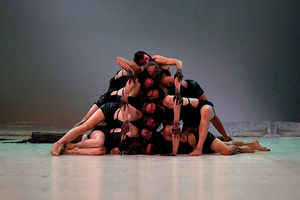 Reviewed by Ray Smith, Friday 12th March 2021.
Reviewed by Ray Smith, Friday 12th March 2021.
I climbed the many stairs of the beautiful, newly rebuilt, Her Majesty's Theatre to reach the lofty heights of the Grand Circle, a perfect vantage point from which to view The Australian Dance Theatre's world premiere of Garry Stewart's
Supernature. The work has taken years in its development and is the latest offering in the choreographer's collection of works titled The Nature Series. As Stewart himself puts it, "Supernature aims to contextualise humans within the fabric, structure, and processes of nature, offering us an image of the human body in confluence with nature's ineffable creativity."
As we all settled into our seats, an empty place between each of us in these troubling times, the sound of clap sticks stole over us in the brightly lit, opulent theatre. A deep and reassuring voice rippled the air in the musical language of the Kaurna people, before reiterating the statements in English. It was a beautiful touch to hear the Welcome to Country by a member and in the language of the First Nation custodians of the area upon which we met.
The house lights dimmed, the curtain rose and the stage was laid open before us. A huge pulsing mass, not unlike a giant jellyfish, dominated the space, surrounded by still, recumbent bodies. Tall, slender, conical columns of purple cloth rose from the corners of the stage up to the roof, where strange, organic pods hung like chrysalides, the pupa of an unfamiliar species. The figures began to move, stretching and contracting in time with the undulations of the central mass, as Brendan Woithe's eerie soundscape spoke of the busy activity of an insect nest or hive.
Damien Cooper's lighting mirrored the disquiet of the sounds, dim and shadowy with a subterranean air, as the grey-clad and still prone dancers froze, their heads high as if listening, like meerkats with lizard bodies. There was an air of reverence as the light softened and an audible pulse developed. The dancers, wearing tubes on their arms, extending them into the forelimbs of quadrupeds, finally stood at the front of the stage and tipped sand from their tubular front legs, forming soft mounds as the material cascaded slowly and audibly onto the surface of the stage.
The sound of air moving, whining and whistling through tunnels, through pipes, through lungs, as a crackling, organic background sound of unending and emotionless industry, heralded the undulating, unhurried departure of the central mass.
A birthing chamber, the very heart of the hive the scene seemed to be, as the dancers moved individually but as one, in instinctive activities like worker ants, backing away in fear or obedience at the approach of a single figure. There was a hierarchy within the collective, and the approaching figure's rank could not be denied, as they were slowly and inexorably driven from the stage.
When the dancers returned, their costumes were reminiscent of simple body armour, with breastplates, hands stained black to the wrist as if they were gloves, and black masks covering mouth and nose like designer PPE. They began to connect to each other as if magnetised, forming complex organic forms that moved together as one, each dancer a segment of an undulating centipede, or the frond of a plant.
I was strongly reminded of the work of Moses Pendleton, the cofounder of Pilobolus and, subsequently, the artistic director of MOMIX, a company of dancer-illusionists, as they described themselves, who also explored the creation of organic forms in dance.
Stewart takes the process considerably further than any work of Pendleton's that I have ever seen, though, and also places the constructed 'creatures' into a very complex narrative, rather than just creating complex forms for the sake of formalism. The dancers were not always using their entire bodies to create their organic illusions, though. Sometimes, a single dancer would be enhanced by the blackened hands of the others, forming a spine and tail for example.
So subtle and engaging was the effect that only one dancer appeared to be there for, even though she was surrounded by several others, our focus was held to the central figure by the artistry of the choreography and the fluid skills of the dancers. I could write reams about the individual moments that struck me throughout, but I would be writing a dissertation rather than a simple review.
The use of props in contemporary dance is de rigueur these days, it would seem, but this performance incorporates an environment that is so intrinsic to the narrative that it goes well beyond set design and into another realm entirely.
The ending is breathtakingly beautiful and I will not pre-empt it here. Not only would it ruin the experience of seeing it live, I simply don't have the words to do it justice.
This is an extraordinary piece of work, utterly flawless in its conception and execution, and I urge you to experience it for yourself.
Comments
To post a comment, you must
register and
login.
 Reviewed by Ray Smith, Friday 12th March 2021.
Reviewed by Ray Smith, Friday 12th March 2021..png)
.png)
 Reviewed by Ray Smith, Friday 12th March 2021.
Reviewed by Ray Smith, Friday 12th March 2021..png)
.png)